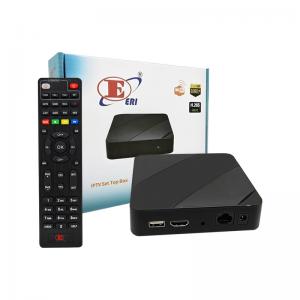

Add to Cart
TCP IP Networking Support Tuner To IPTV Small MOQ Iptv Linux
Receiver
Iptv Linux Receiver Description:
IP Datacast (IPDC) is an IP-based service used to deliver video,
audio, graphics and data
via virtually any broadband delivery system. The data is
encapsulated in an IP (Internet Protocol)
packet data stream. If the data is TV content it is also called
IPTV.
Iptv Linux Receiver Specification:
- O.S:Linux 4.9
- CPU Frequency:1500DMIPS 32bit
- Flash:16MB
- DDR3:1Gb=1024Mb=128MB
- IPTV protocol:HLS(M3U8),UDP,RTP,RTSP,RTMP,HTTP
- Resolution:1080p, 1080i, 720p, 576p, 480p, etc
- Sampling Frequency:32KHz, 44.1KHz, 48KHz
Application With Iptv Linux Receiver:
- Cable TV Operator
- Pay TV Operator
- Internet Service Provider
- Content Provider
- Personal Usage
- HD set-top box
Features of Iptv Linux Receiver:
- Built-in 128MB DDR3 SDRAM
- The multi-standard video decoder supports JPEG/MJPEG, MPEG2, AVS, AVS plus,
MPEG4, H.264, H.265 10bit/60fps HD or SD advanced video decoding. Error
protection and concealment supported
- HDR video decoding and display Supported
- All of the PAL and NTSC analog TV standards supported
Advantages for Iptv Linux Receiver:
1. Positive Reputation in the Market
2. Comprehensive Product Warranty
3. Proven Track Record of Successful Products
4. Genuine Customer Engagement
5. Proactive Market Research
FAQ:
1. How can I protect my set-top box from viruses and malware?
Install Antivirus Software: You can install antivirus software on
your set-top box to protect it from viruses and malware.
Regularly update the Operating System: Make sure you have the
latest version of the operating system
installed on your set-top box because the latest version often
includes security updates, bug fixes,
and performance-enhancing features.
Use a reliable source for apps: Use a reliable source such as the
official app store to download
and install apps on your set-top box. There are many rogue apps
that can contain viruses and malware.
Be cautious about email attachments: Do not open email attachments
unless they come
from someone you know and trust. Viruses and malware can be
transmitted through email
and other messaging apps.
Use a VPN: If you stream content from untrusted websites or if you
connect your set-top box to
public Wi-Fi, you should use a VPN to protect your data from
hackers.
Disconnect when not in use: When you are not using your set-top
box, disconnect it from the internet.
This will prevent malware from being installed or propagating
through your device while you're not using it.
2. Can I use a set-top box with satellite TV?
Most satellite receivers are totally dedicated to watching TV, very
few are also multifunctional
devices also capable of playing media from a network but there are
a few. The CPU in many satellite
receivers is not very powerful and they have very little memory,
instead they have specific cores for
decoding audio and video. So they pretty mucg suck for doing much
else.
Also the software for each receiver is quite custom, so running
other applications is hard and operators
don't like people playing with them.
3. How do I add new channels to my set-top box?
Scan for channels: Most set-top boxes have a channel scan feature
that allows you to search for new channels.
This feature can usually be found in the settings or menu of the
set-top box. The scan may take a few minutes to complete.
Manually add channels: If the channel scan doesn't find the
channels you want to add, you may be
able to manually add them. This usually involves entering the
channel frequency or signal information
into the set-top box.
4. Can I use a set-top box to play video games?
You can experience these high-quality video games on your big
screen without the need for any
heavy gaming hardware. Use the remote that comes bundled with the
set-top-box or any Bluetooth-enabled
game controller or even your own smartphone to enjoy an effortless
gaming experience on your TV.
5. Is a set-top box compatible with a digital antenna?
A set-top box can be compatible with a digital antenna, but it
depends on the specific set-top box and
the digital antenna you are using.
Many set-top boxes, such as those for cable or satellite TV, are
designed to work with a specific type
of antenna or signal. In this case, you may need to check with the
manufacturer of your set-top box to
see if it is compatible with a digital antenna.
However, if you have a set-top box that is designed to receive
over-the-air broadcasts,
it should be compatible with a digital antenna. In fact, using a
digital antenna with a set-top box can provide
you with access to local channels and programming that may not be
available through your cable or satellite provider.
To use a digital antenna with a set-top box, you will need to
connect the antenna to the input on the set-top box
using a coaxial cable. Then, you can use the set-top box to scan
for available channels and watch them on your TV.
